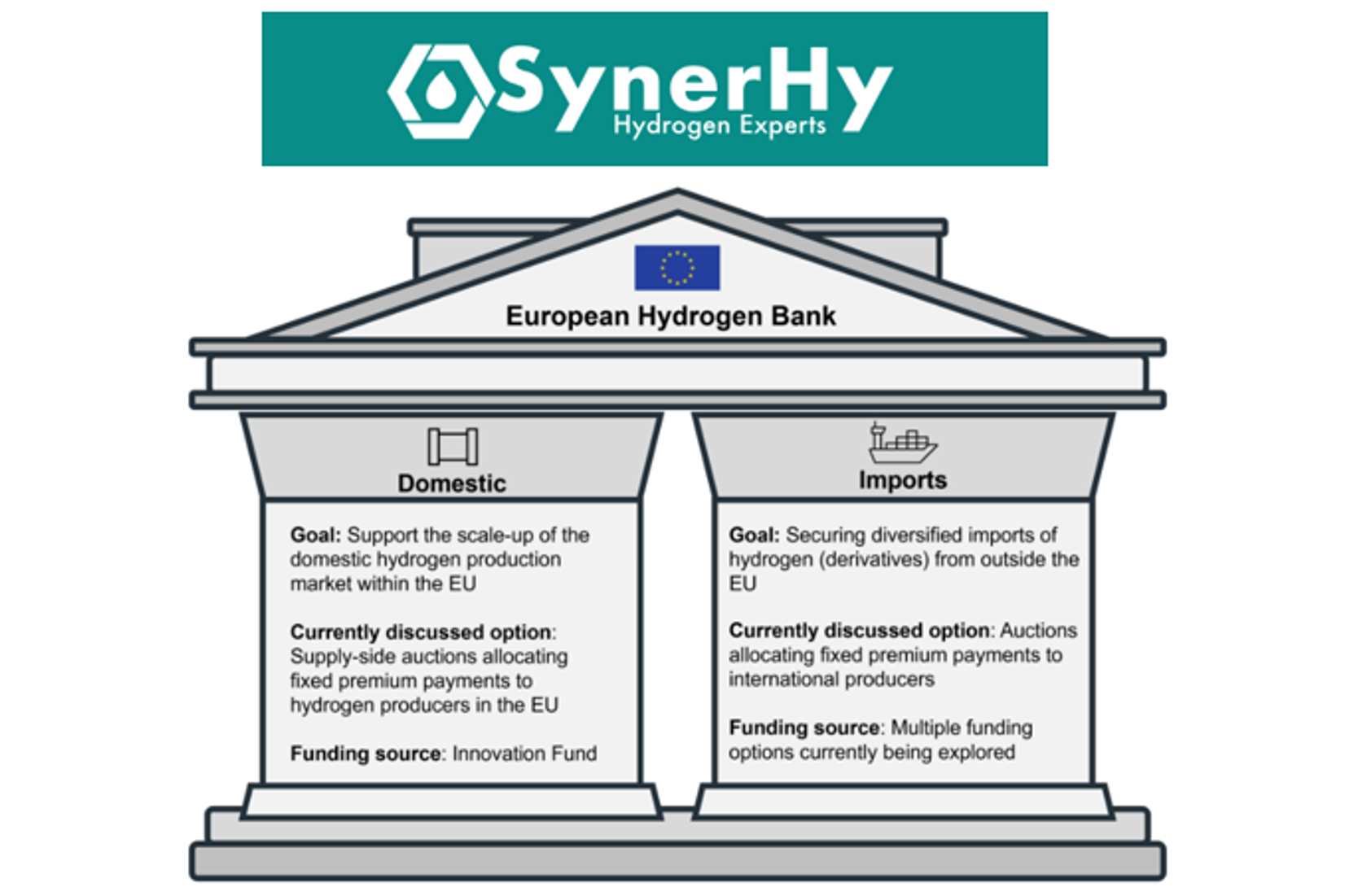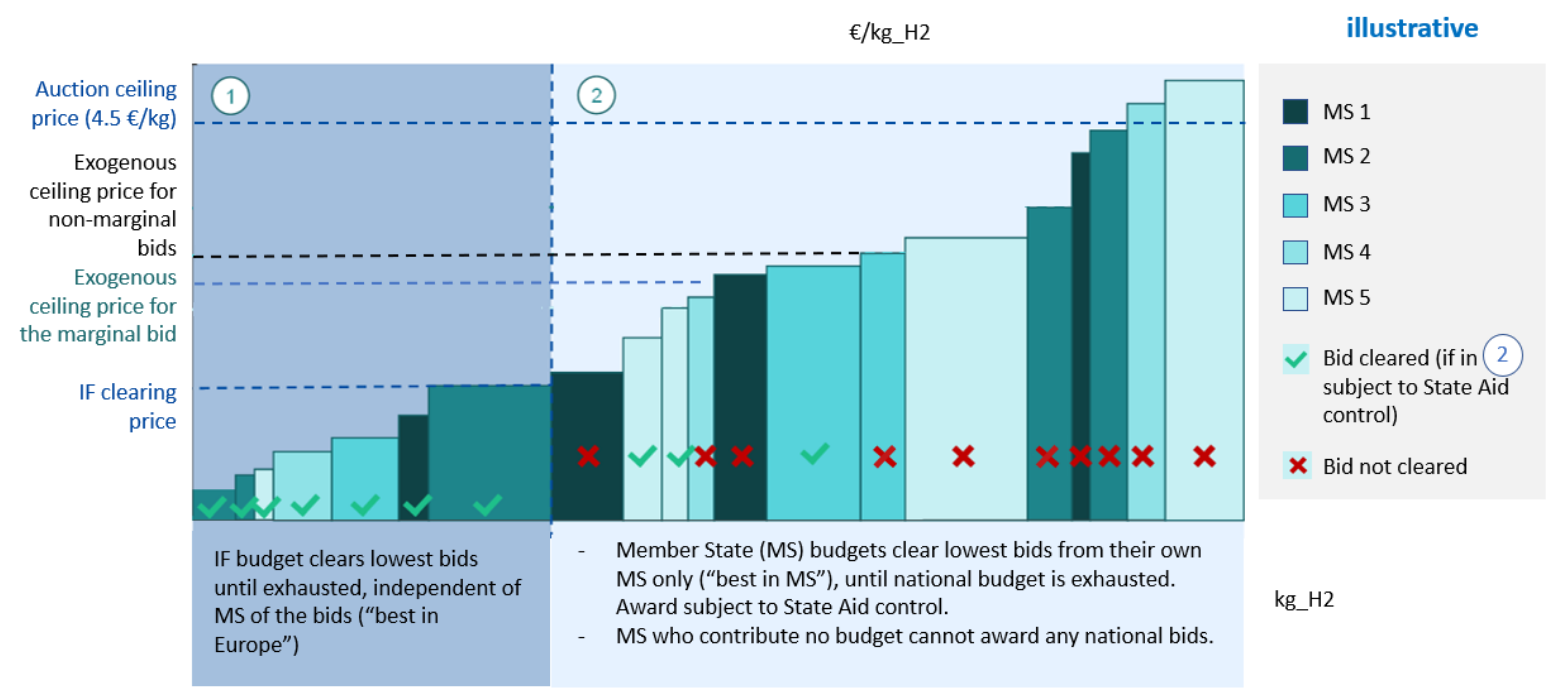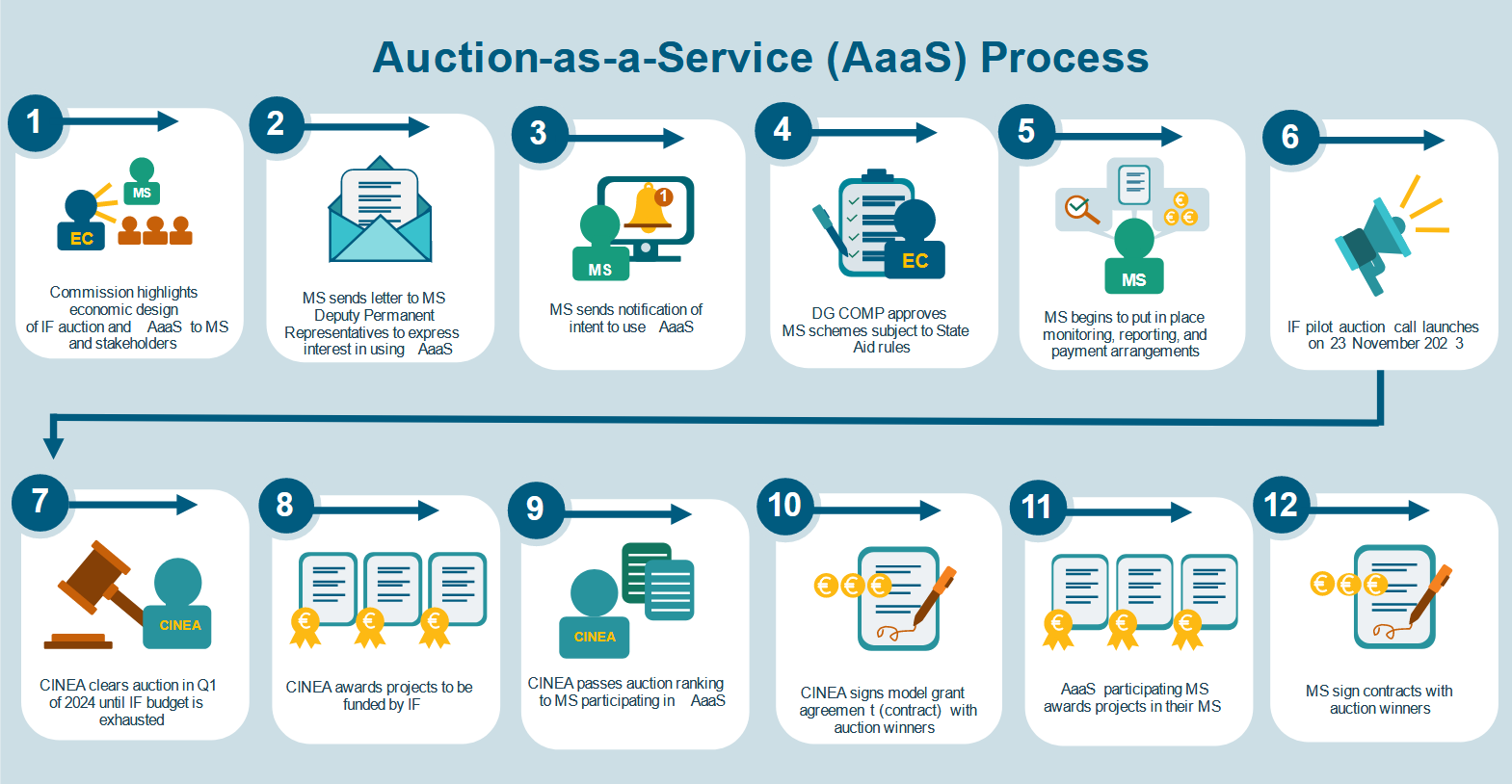First European Hydrogen Bank Auction
November 23rd, the European Commission announced the first €800 million in grants from the European Economic Area Innovation Fund to support renewable hydrogen production through a series of auctions jointly managed by the European Hydrogen Bank (Article on the European Hydrogen Bank, European Economic Area European Hydrogen Bank: Inminent release and auction schemes | SynerHy) and by CINEA (European Climate, Infrastructure and Environment Executive Agency).

Figure 1. Outline of the European Hydrogen Bank’s Objectives
The European Hydrogen Bank aims to promote the construction of a renewable hydrogen market, stimulate investment in production capacity and cooperate in achieving the targets set by the European Union in the REPowerEU plan, which calls to produce 10 Mt of hydrogen by 2030.
Producers of renewable hydrogen (whose characteristics are defined in the delegated acts of the Renewable Energy Directive) will be able to bid for support in the form of a fixed premium per kilogram of H2 produced, with the aim of reducing the price compared to non-renewable hydrogen. These bids must be based on a proposed price premium per kilogram of renewable hydrogen produced, up to a limit on the final price of 4.5 €/kg.
Objectives
The European Hydrogen Bank sets out a list of objectives for the auction systems, which includes:
- Reducing the gap between renewable and non-renewable hydrogen. Building on the success of auctions in the renewable sector, where the profitability of installations was achieved by lowering the financing requirements of power generation through price competition, as well as mobilising the private sector.
- Enabling price discovery and the formation of a renewable hydrogen market. Competitive auctions with a simple and transparent set-up can be a good driver for the European hydrogen market.
- Lowering the risk of European hydrogen projects. By linking domestic renewable hydrogen supply to demand, and increasing the likelihood of return on investment, this will be an advantage for private investment.
- Reducing the administrative burden and associated costs, thanks to the implementation of short and transparent procedures.
Auctions-as-a-Service (AaaS)
The commission will run a single auction, identifying the projects to which the requested premiums will be granted, first with funds from the subsidies provided by the Innovation Fund (until the investment in the most competitive projects is exhausted) and subsequently with the different national budgets. This approach will show advantages in the European markets and in the competitiveness of the sector.
Member States wishing to participate will have to allocate national budget to be able to participate in the AaaS and thus continue with the process of State aid notifications; these national contributions will not enter into the EU or Innovation Fund budget, they will remain as a State resource, which will be implemented as subsequent support to the different projects. The different members of the Union that have committed to a national auction budget will award projects on their own territory beyond those awarded by the Innovation Fund budget, fully respecting the ranking resulting from the auction. Member States will be responsible for signing contracts, making payments and monitoring projects.

Figure 2. Auction System
The European Commission together with the European Hydrogen Bank will provide a number of services to the projects applying for support in the auction:
- The Commission provides the CEEAG (The Climate, Energy and Environmental Aid Guidelines) compatible with the auction designs to Member States.
- The Commission will provide state aid notifications from Member States.
- CINEA will guide the qualification check of the proposals, inform Member States of the resulting price ranking. An exogenous formula will be established to limit prices at EU level.
- The Commission will provide guidance for the minimum requirements needed at national level.
- The possibility of a common exchange of knowledge gained from the projects, as well as sharing of “lessons learned”. The Commission will play an active role in the organisation of knowledge and best practices exchange between the awarded projects in the auction.
In practice the AaaS will work as follows, from the perspective of a Member State:
1. CINEA will launch the Innovation Fund auction on the announced date.
2. Project developers will upload their proposals, indicating whether they are interested in the national window of the AaaS funds.
3. Projects across Europe will notify their bids, which will be evaluated, ranked, and collected in line with the conditions and terms of the auction.
4. The lowest bids will be collected in the Innovation Fund budget, until the €800 million has been exhausted.
5.CINEA will include a certain number of eligible projects in the reserve list, these projects meet the criteria, but:
-
- They have not been awarded as an Innovation Fund project.
- They are projects from a Member State that has agreed to participate in the AaaS or has not indicated its willingness to be proposed.
- They have participated in the AaaS, but their bid is not below the maximum price, and does not fall within the AaaS budget. In these cases, CINEA may contact the project developers and propose their inclusion in the Innovation Fund.
6. Short-listed national projects: have passed the qualification criteria, their bid could not be awarded the Innovation Fund budget, have had interest in AaaS, enter the national funding window.
7. Members are obliged to respect the price marked in the ranking and the lowest bid will be collected according to the national funds window.
8. Member States will receive a list of pre-selected national projects, if not selected, the states will coordinate with the commission to transfer additional national projects to a reserve list of the Innovation Fund. CINEA will ask the developers of these projects if they wish to be transferred.
9. CINEA is responsible for awarding, contracting, and overseeing support for projects within Innovation Fund budgets.
10. Member States are responsible for awarding, contracting, and monitoring project support within the national budget.

Figure 3. Auction-as-a-Service Process
One of the main objectives of the European Union is to propose a development of the AaaS that can be modified for future auctions, to present a fairer and more equitable system for all bidding projects. According to the words of the President of the European Commission Ursula Von der Leyen: “The lessons learned from this pilot auction will be used in the second auction in spring 2024, with a total of 2.2 billion €”. It is also proposed to create a project portfolio to share the different knowledge obtained in the development of the projects, thus achieving greater efficiency in the progress of the EU’s decarbonization plans, as well as the necessary economic evolution of the technologies of the hydrogen value chain.
Tenderers have until April 9, 2024, at 5 p.m. (Central European Time), to submit their application through the EU Funding and Tender Portal.
World Bank Proposal
Last November, the World Bank announced that proposes the accelerated deployment of green hydrogen as a low-carbon energy source, including an initiative to generate 10 GW of power, ten times the current production capacity using renewable energy.
The plan, proposed by the World Bank in collaboration with the OECD (Organization for Economic Cooperation and Development), the G20-linked Global Infrastructure Facility, and the Hydrogen Council, calls for hydrogen production using renewable energy or carbon capture mechanisms. According to the plan, the 10 GW will be divided into projects ranging from 100 MW to 1 GW, while forums will be created to develop production and commercialisation standards, as well as to strengthen access to clean energy in developing countries to ensure the viability of this technology, reduce its financing costs and increase the speed of adoption through economies of scale.
The World Bank is helping to reduce costs by designing financing mechanisms to reduce project risk and promote policies that boost demand. So far this year, the multilateral organisation has granted loans for 1,650 million dollars (1,517 million euros) to finance renewable hydrogen.
Conclusions
With this initiative proposed by the European Union, it is expected to achieve results capable of improving the competitiveness of renewable hydrogen production and marketing against non-renewable hydrogen in the short term. This would lead to an overall boost in the entire renewable hydrogen value chain, and at the same time, contribute to achieving the renewable hydrogen production targets defined by the EU.
As in the case of the rest of the EU funding grants (REPowerEU, Fit-For-55, Next GenarationEU, etc.), they will reduce costs for investors in the technologies associated with the production and consumption of renewable hydrogen, as well as adding an extra push for the profitability of the projects in which the commercialisation of renewable hydrogen is envisaged.
The pilot auction will allow the Commission to collect reliable data on the EU’s renewable hydrogen project portfolio, the level of competition for this type of aid, the costs of renewable hydrogen production and its market price.
REFERENCES